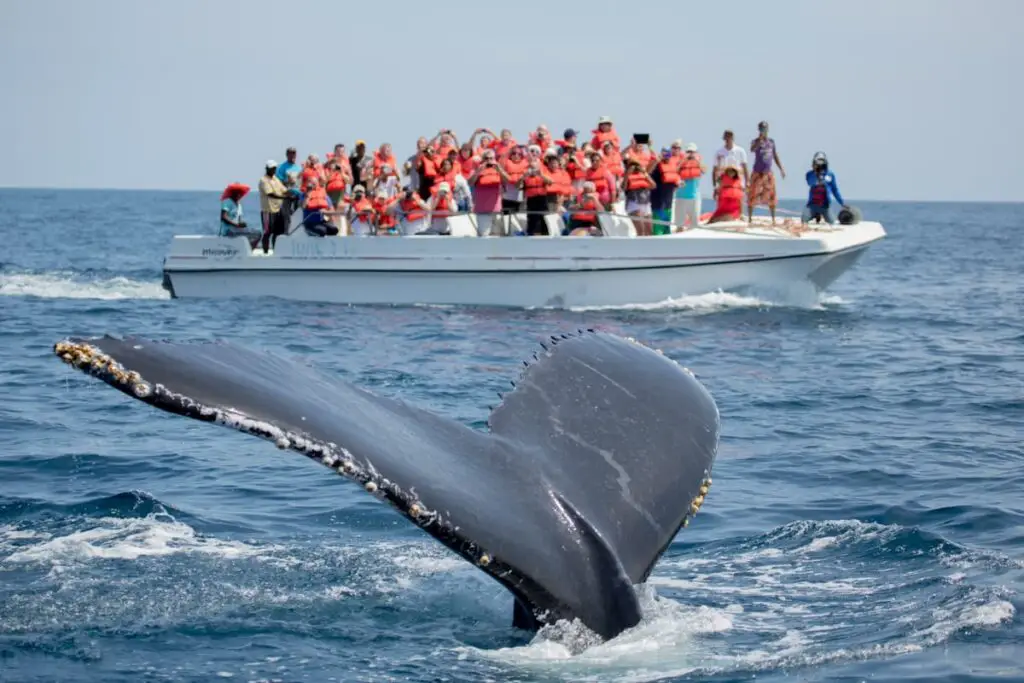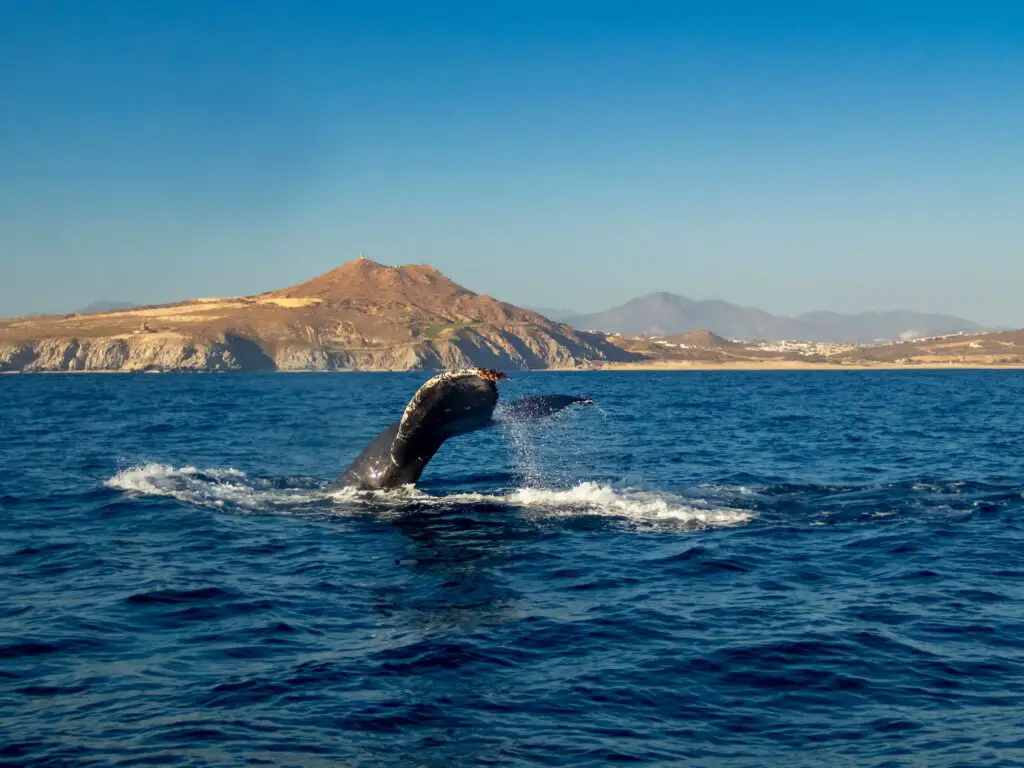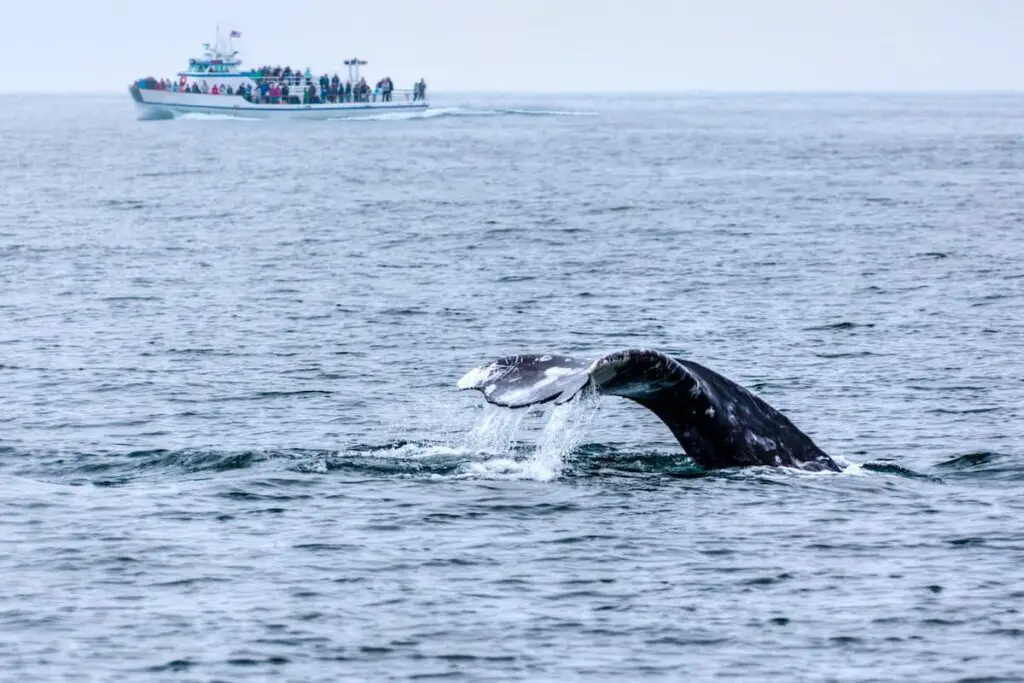As an Amazon Associate, we earn from qualifying purchases. We may also earn commissions if you purchase products from other retailers after clicking on a link from our site.
There are dozens of whale-watching havens along the east and west coasts and from Alaska to Hawaii. But your whale-watching experience shall depend largely on the weather on a given day at your chosen hotspot. So, you should know a bit about the best weather for whale watching.
The best weather for whale watching is clear and dry conditions with glassy water. High swells and waves, strong wind, and heavy or persistent rain are not ideal for any whale-watching spot, offshore or onshore. Sunny days aren’t necessary, but visibility matters.
Onshore and offshore weather aren’t identical. Plus, offshore conditions can change rapidly with little or no forecast information. The probable weather issues also depend on the place, season, and time of the day. Read on to learn everything about the best weather for whale watching.

When Should You Go Whale Watching?
At least 3 interrelated factors will determine when you should go whale watching:
- Real-time weather conditions at a place
- The time of the day for whale watching
- The whale watching season you choose
The whale watching season depends on where you are or will be touring. The season will have an inevitable impact on the possible weather conditions, and the specific time of the day of your whale-watching adventure is likely to have localized influences, especially offshore.
The Real-Time Weather Conditions at a Place
There are at least 5 oceanic weather conditions you should avoid for a pleasant whale-watching experience:
- Fog and mist
- Heavy rain
- Strong wind
- Swells
- Waves
I must mention that these conditions don’t necessarily affect whale activity so much as they will impair your visibility. Consider the example of choppy waters.
The majestic cetaceans can be active in choppy waters, feed, move, and surface as they would otherwise, but the swells and waves will, in most likelihood, prevent you from spotting a whale. Even large blows may disperse swiftly if the waves are large or the wind is strong.
Likewise, fog and mist above the water won’t deter any whale species from its routine activity, but the low visibility will make your spotting and watching difficult and sometimes totally futile.
A few real-time weather conditions at a place are not necessarily a deal-breaker, such as the following:
- Clouds
- Drizzle
- Low light
- Mild wind
- Unclear water
Cloudy or overcast conditions aren’t a problem as long as there’s no visibility issue due to fog or mist. Similarly, light rain is unlikely to create gigantic splashes to hinder your views. And slightly unclear water, for whatever reason, is unlikely to conceal blowing and surfacing whales.
Low light and mild wind are dynamic and subjective issues. Fading or low ambient light, which is basically not a bright sunny day or the peak sunlight hours, may not be an issue for those with great eyesight unless it gets dark enough to impair your visibility.
The wind issue is a bit more topical because the speed can change suddenly and its impact on the ocean varies across the regions. For instance, the Pacific or West Coast has higher waves and wind speeds than the Atlantic or East Coast.
Additionally, what is a light breeze or mild wind isn’t the same everywhere throughout the year. Take the example of a gentle breeze rated as Force 3. Such a breeze with a speed of 8 to 12 mph (7 to 10 knots) causes large wavelets, and the crests begin to break.

The ocean or sea is no longer like a mirror or with glassy water as it stays in Force 0 as per the Beaufort Wind Scale. But you may still plan your whale-watching adventure at Force 3. Force 4 isn’t ideal, and you must get lucky with a lot of whale activity at the surface to spot one or more.
Force 4 wind speed is 13 to 18 mph (11 to 16 knots), creating small waves that become larger and form white horses. Breaking waves in Force 4 complicate whale watching. And Force 5 will make it nearly impossible for you to spot whales.
Besides, wavy and windy sailing makes for a rough experience, which may cause motion or seasickness if you aren’t accustomed to or immune to it.
The Best Time of the Day for Whale Watching
Whales are active almost throughout the day, but different times have a few advantages and disadvantages. Here’s what you may expect at distinct hours of the day while whale watching:
- Mornings generally have calmer water and gentler wind, so they are suitable for whale watching. Also, whales are known to surface feed in the day and night, and be crepuscular, which means they like to feed during the twilight hours of dawn and dusk.
- Midday is an opportune time slot because most tour operators figure out the spots with the maximum whale activity by this time on a given day. However, noon and afternoon hours may usher in some weather disturbances, depending on where you are.
- Afternoon and early evening hours, especially around sunset, are good times for whale watching. The twilight hours are also when krill swarms swim toward the surface to feed, and cetaceans eat these crustaceans, especially the baleen whales.
Therefore, you may plan your whale-watching adventure throughout the day if the weather isn’t a bummer.
Whale-Watching Seasons and Spots
The whale watching seasons in many popular spots include the wettest months. Also, several hotspots are known for unpredictable weather. Consider the example of Alaska. The state has several whale-watching hotspots, including:
- Glacier Bay: June through August to watch blue, humpback, and minke whales.
- Juneau: April through November is the season for this haven of humpback whales.
- Kodiak Island: April for gray whales; June through November for fins and humpbacks.
- Seward: May to September for gray, humpback, and minke whales, among others.
Most of these periods include August, the wettest month for coastal Alaska. Also, the weather in Alaska can be very unpredictable, particularly starting in September with cool winds, overcast skies, rainstorms, etc. Besides, long spells of unbroken rain are common in the state.

In contrast, California and New York on the two coasts have reasonably pleasant weather for whale watching. California also has a much longer whale-watching season than Alaska, New York, etc. So, you can choose a day with the best weather for whale watching.
Consider the following whale watching seasons in California:
- Big Sur and Monterey Bay: blue and humpback whales from April to December and grays from January through March.
- Newport Beach: blues from May through November and gray whales from December to April.
- San Diego: gray whales from late December to March, with the peak being mid-January.
- Santa Barbara: May to September for blue whales and February to April for grays.
You may also want to know what time of the year it rains in California when planning for whale watching. Read my guide on where and when you should expect rain in California to plan your trip accordingly. [When Does it Rain in California?]
Long Island in New York has a shorter season from July to September for around half a dozen whale species, but this period has mostly pleasant weather, except for the odd hurricanes.
Virginia Beach hosts the migrating blue, fin, and humpback whales from December through March. The winter months in Virginia are unlikely to be rainy, but offshore visibility may be an issue at times.
The weather of the whale watching havens in Hawaii, such as the Big Island and Maui, is also unpredictable. But a large number of active, mating, and nursing humpback whales in these waters from November to May are easier to spot and watch on tour.
Final Thoughts
The best weather for whale watching is a dry day with calm and glassy water and without large waves or strong winds. But a drizzle and moderate breeze shouldn’t spoil your day unless there is little whale activity and visibility is a concern. Tides don’t influence whale-watching tours.
